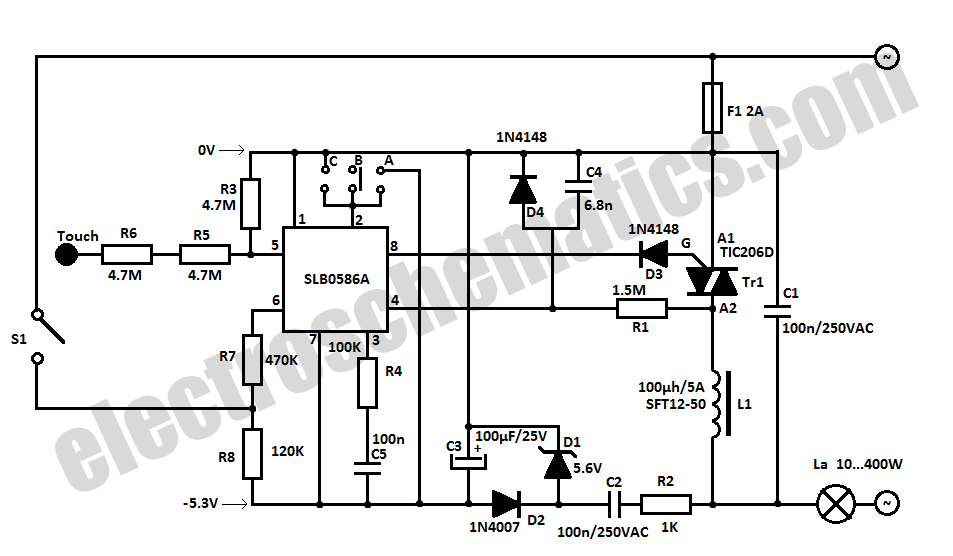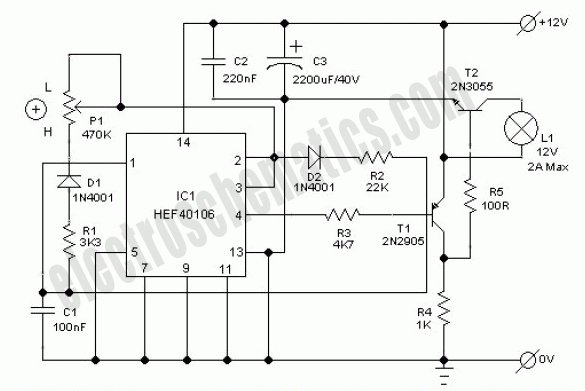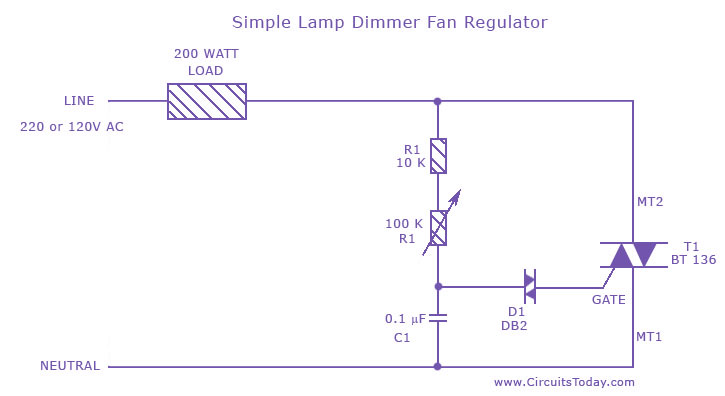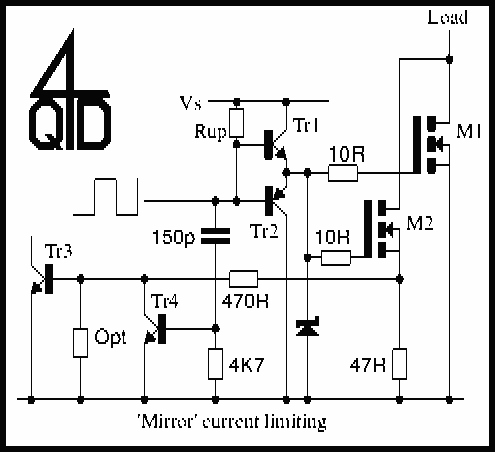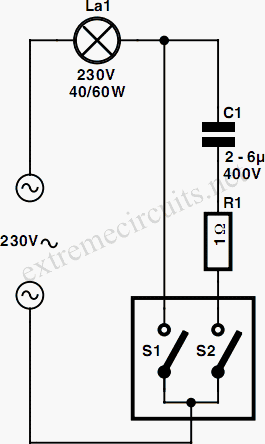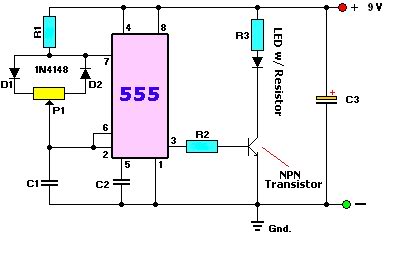
Dimmer With A MOSFET

This circuit demonstrates that dimmers designed for mains voltage do not necessarily require a triac. Instead, a MOSFET (BUZ41A, 500 V/4.5 A) is utilized within a diode bridge to manage the voltage across an incandescent bulb using pulse-width modulation (PWM). A suitable PWM controller can be referenced in another section of this issue. The gate driving power supply voltage is derived from the voltage across the MOSFET. The components D6, R5, and C2 form a rectifier, with R5 limiting the current pulses through D6 to approximately 1.5 A, resulting in a non-pure peak rectifier. The voltage across C2 is regulated to a maximum of 10 V by R3, R4, C1, and D1. An optocoupler, along with resistor R2, is employed to drive the gate. Resistor R1 serves as protection for the optocoupler's LED and also acts as a current-limiting device to ensure safe application of a hard voltage. The optocoupler used is the CNY65, which provides class-II isolation, ensuring the safety of the regulator. The transistor in the optocoupler is connected to the positive power supply to facilitate rapid conduction of T1. To mitigate switching spikes caused by parasitic inductance, R2 is chosen to be 22 kΩ, which represents a balance between inductive voltages and switching losses during transitions. Additionally, T1 may conduct longer than expected solely based on the PWM signal. As the voltage across T1 decreases, the voltage across D1 remains at 10 V up to a duty cycle of 88%. A higher duty cycle leads to a reduced voltage, with 4.8 V at a duty cycle of 94%, which is the threshold for adequate conduction of T1. At 230 V mains voltage, the voltage across the lamp measures only 2.5 V lower when using a 100 W lamp. It is important to note that this circuit is not suitable for controlling inductive loads. T1 operates asynchronously with the mains frequency, which may result in DC current flow. Electronic lamps, such as PL types, cannot be dimmed using this circuit as they utilize a rectifier and function on DC internally. Regarding the values of R3 and R4, these are a compromise between minimizing current consumption when the lamp is off and maximizing the permissible duty cycle. When the duty cycle is zero, the voltage across these resistors reaches its maximum, around 128 V with a mains voltage of 230 V. Since the voltage rating of the resistors may be below 300 V, two resistors are connected in series. Each resistor's maximum power dissipation is approximately 0.5 W, thus it is advisable to use two resistors rated at 1 W to enhance longevity.
The described circuit utilizes a MOSFET-based dimming solution that effectively manages incandescent bulb brightness by adjusting the voltage through PWM techniques. The MOSFET (BUZ41A) is a crucial component, acting as a switch in the circuit, allowing for efficient control of the power delivered to the load. The diode bridge configuration serves to rectify the AC signal, providing a DC voltage to the control circuitry.
The PWM controller is essential for modulating the power to the load. By varying the duty cycle, the average power delivered to the incandescent bulb can be adjusted, allowing for smooth dimming capabilities. The choice of components, such as the optocoupler (CNY65), enhances safety by providing electrical isolation between the high voltage and low voltage sections of the circuit.
The current limiting resistor (R5) and the rectifying diode (D6) are critical in managing the current flow, preventing excessive current that could damage the components. The capacitor (C2) helps in smoothing the rectified voltage, ensuring stable operation of the circuit.
The design considerations for resistors R3 and R4 emphasize the importance of balancing power consumption and voltage ratings. The series configuration of these resistors is a prudent choice for maintaining reliability under varying operational conditions.
Overall, this circuit exemplifies a robust and efficient approach to dimming incandescent lighting while ensuring safety and reliability through careful component selection and configuration.This circuit shows that dimmers intended for use at mains voltage do not always have to contain a triac. Here, a MOSFET (BUZ41A, 500 V/4. 5A) in a diode bridge is used to control the voltage across an incandescent bulb with pulse-width modulation (PWM).
A useful PWM controller can be found elsewhere in this issue. The power supply voltage for drivi ng the gate is supplied by the voltage across the MOSFET. D6, R5 and C2 form a rectifier. R5 limits the current pulses through D6 to about 1. 5 A (as a consequence it is no longer a pure peak rectifier). The voltage across C2 is regulated to a maximum value of 10 V by R3, R4, C1 and D1. An optocoupler and resistor (R2) are used for driving the gate. R1 is intended as protection for the LED in the optocoupler. R1 also functions as a normal current limiting device so that a hard` voltage can be applied safely. The optocoupler is anold acquaintance, the CNY65, which provides class-II isolation. This ensures the safety of the regulator. The transistor in the optocoupler is connected to the positive power supply so that T1 can be brought into conduction as quickly as possible. In order to reduce switching spikes as a consequence of parasitic inductance, the value of R2 has been selected to be not too low: 22 k is a compromise between inductive voltages and switching loss when going into and out of conduction.
An additional effect is that T1 will conduct a little longer than what may be expected from the PWM signal only. When the voltage across T1 reduces, the voltage across D1 remains equal to 10 V up to a duty cycle of 88 %.
A higher duty cycle results in a lower voltage. At 94 % the voltage of 4. 8 V proved to be just enough to cause T1 to conduct sufficiently. This value may be considered the maximum duty cycle. At this value the transistor is just about 100 % in conduction. At 230 V mains voltage, the voltage across the lamp is only 2. 5 V lower, measured with a 100-W lamp. Just to be clear, note that this circuit cannot be used to control inductive loads. T1 is switched asynchronously with the mains frequency and this can cause DC current to flow. Electronic lamps, such as the PL types, cannot be dimmed with this circuit either. These lamps use a rectifier and internally they actually operate off DC. A few remarks about the size of R3 and R4. This is a compromise between the lowest possible current consumption (when the lamp is off) and the highest possible duty cycle that is allowed. When the duty cycle is zero, the voltage across the resistors is at maximum, around 128 V with a mains voltage of 230 V.
Because (depending on the actual resistor) the voltage rating of the resistor may be less than 300 V, two resistors are connected in series. The power that each resistor dissipates amounts to a maximum of 0. 5 W. With an eye on the life expectancy, it would be wise to use two 1-W rated resistors here. 🔗 External reference
The described circuit utilizes a MOSFET-based dimming solution that effectively manages incandescent bulb brightness by adjusting the voltage through PWM techniques. The MOSFET (BUZ41A) is a crucial component, acting as a switch in the circuit, allowing for efficient control of the power delivered to the load. The diode bridge configuration serves to rectify the AC signal, providing a DC voltage to the control circuitry.
The PWM controller is essential for modulating the power to the load. By varying the duty cycle, the average power delivered to the incandescent bulb can be adjusted, allowing for smooth dimming capabilities. The choice of components, such as the optocoupler (CNY65), enhances safety by providing electrical isolation between the high voltage and low voltage sections of the circuit.
The current limiting resistor (R5) and the rectifying diode (D6) are critical in managing the current flow, preventing excessive current that could damage the components. The capacitor (C2) helps in smoothing the rectified voltage, ensuring stable operation of the circuit.
The design considerations for resistors R3 and R4 emphasize the importance of balancing power consumption and voltage ratings. The series configuration of these resistors is a prudent choice for maintaining reliability under varying operational conditions.
Overall, this circuit exemplifies a robust and efficient approach to dimming incandescent lighting while ensuring safety and reliability through careful component selection and configuration.This circuit shows that dimmers intended for use at mains voltage do not always have to contain a triac. Here, a MOSFET (BUZ41A, 500 V/4. 5A) in a diode bridge is used to control the voltage across an incandescent bulb with pulse-width modulation (PWM).
A useful PWM controller can be found elsewhere in this issue. The power supply voltage for drivi ng the gate is supplied by the voltage across the MOSFET. D6, R5 and C2 form a rectifier. R5 limits the current pulses through D6 to about 1. 5 A (as a consequence it is no longer a pure peak rectifier). The voltage across C2 is regulated to a maximum value of 10 V by R3, R4, C1 and D1. An optocoupler and resistor (R2) are used for driving the gate. R1 is intended as protection for the LED in the optocoupler. R1 also functions as a normal current limiting device so that a hard` voltage can be applied safely. The optocoupler is anold acquaintance, the CNY65, which provides class-II isolation. This ensures the safety of the regulator. The transistor in the optocoupler is connected to the positive power supply so that T1 can be brought into conduction as quickly as possible. In order to reduce switching spikes as a consequence of parasitic inductance, the value of R2 has been selected to be not too low: 22 k is a compromise between inductive voltages and switching loss when going into and out of conduction.
An additional effect is that T1 will conduct a little longer than what may be expected from the PWM signal only. When the voltage across T1 reduces, the voltage across D1 remains equal to 10 V up to a duty cycle of 88 %.
A higher duty cycle results in a lower voltage. At 94 % the voltage of 4. 8 V proved to be just enough to cause T1 to conduct sufficiently. This value may be considered the maximum duty cycle. At this value the transistor is just about 100 % in conduction. At 230 V mains voltage, the voltage across the lamp is only 2. 5 V lower, measured with a 100-W lamp. Just to be clear, note that this circuit cannot be used to control inductive loads. T1 is switched asynchronously with the mains frequency and this can cause DC current to flow. Electronic lamps, such as the PL types, cannot be dimmed with this circuit either. These lamps use a rectifier and internally they actually operate off DC. A few remarks about the size of R3 and R4. This is a compromise between the lowest possible current consumption (when the lamp is off) and the highest possible duty cycle that is allowed. When the duty cycle is zero, the voltage across the resistors is at maximum, around 128 V with a mains voltage of 230 V.
Because (depending on the actual resistor) the voltage rating of the resistor may be less than 300 V, two resistors are connected in series. The power that each resistor dissipates amounts to a maximum of 0. 5 W. With an eye on the life expectancy, it would be wise to use two 1-W rated resistors here. 🔗 External reference
